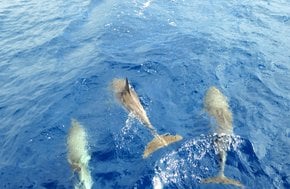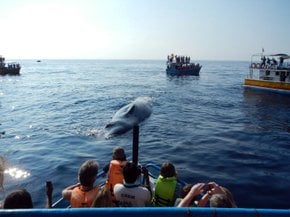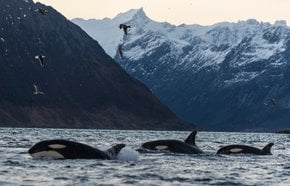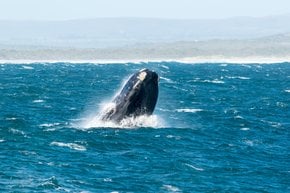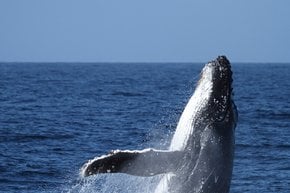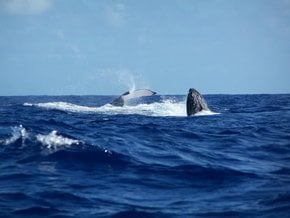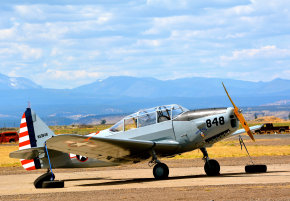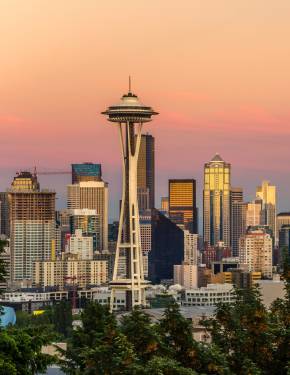Whale Watching in Oregon 2025
Enjoy the biannual gray whale migration off the Oregon coast
Best time: March–May | mid-December–mid-January (all year)
There are approximately 80 species of whales, dolphins, and porpoises, with about 10 of these found off the coast of Oregon. Among them are the majestic gray whale, the impressive killer whale, and the delightful and intelligent bottlenose dolphin.
Best Time to See Whales
Every winter, from mid-December to mid-January, about 20,000 gray whales pass the coast of Oregon on their way to the warm waters of Baja California Sur in Mexico. They return north from March through May. This period is the best time to observe whales in Oregon. However, some species can be spotted in local waters throughout the entire year.
Best Places for Whale Watching
Depoe Bay
Depoe Bay is renowned as Oregon's premier whale-watching destination and is often called the whale-watching capital of the Oregon coast. The Whale Watching Center in Depoe Bay operates year-round and attracts thousands of visitors. During migration season, boats frequently depart from the harbor, providing tourists with informative insights and stories about whales. Pods of gray whales are commonly seen in Depoe Bay, with a 98% success rate for sightings during peak months. Whale watching continues in the summer and fall, and some gray whales remain in the area year-round, feeding off local reefs. Visitors may also spot harbor seals, seabirds, and other unique marine life.
Newport
Newport hosts gray whales year-round thanks to a resident population of approximately 60 whales that stays off the Oregon coast. Additionally, around 200 visiting whales pass through Newport. Between Lincoln City and Newport, about 40 whales are often found, attracted by the rich food supply in the area.
Whale-Watching Tours
For a quick 1 to 2-hour whale-watching experience, look for local charters that offer tours in your area. Prices are typically around $40 or less per adult. During winter, you might see whales heading south, while in spring and summer, they may be traveling north. Keep an eye out for spectacular sights like whales breaching or swimming close to the surface. Additionally, many operators provide group tours for families and school groups, with pricing that often includes discounted rates for children and free admission for toddlers under 3.
Whale-Watching Season
Most whale species off the coast of Oregon are migratory. For example, gray whales travel from their feeding grounds in the nutrient-rich Bering Sea or the Gulf of Alaska to their calving grounds in the warm, shallow waters of the Sea of Cortez in Mexico. Late spring and summer are ideal times to view gray whales. However, with a warm coat and some hot chocolate, winter can also be an excellent season for observing these magnificent creatures on their journey south.
Gray Whale (Summer & Winter)
Gray whales (Eschrichtius robustus) are renowned for their remarkable migration, the longest of any mammal on Earth. Each year, they travel over 10,000 miles (16,093 kilometers) from Alaska to Mexico and back. This incredible journey demands substantial food and energy, which they acquire by feeding heavily in the nutrient-rich waters off Alaska's southern coast. As baleen whales, gray whales use bristly growths in their mouths to filter their food. They can grow up to 49 feet (15 meters) long and weigh as much as 40 tons.
Whale-Watching Tips
Expect windy conditions while on your cruise, and be aware that water can reflect UV light, increasing the risk of sunburn even on sunny days. If this is your first boat ride, prepare for the possibility of motion sickness by bringing over-the-counter medications. Remember that nature and weather can be unpredictable; while knowing the forecast and potential marine animals can help, each tour is unique. Embrace the adventure and hope for a rewarding experience.
What to Wear
Dress in warm layers, especially for winter tours, and consider a windbreaker as your outer layer. It's easier to remove clothing if you get too warm. Also, wear long pants, a hat, and closed-toed shoes, and apply sunscreen to protect yourself from UV rays. While many tours offer sheltered areas on the boat, being prepared for various conditions will ensure you have a great time on the water.
What to Bring
Concessions for food and water might be available, but it's always a good idea to bring some snacks and a beverage with you. To enhance your wildlife viewing experience, consider bringing binoculars; they can make a significant difference, allowing you to see details like the whiskers on a harbor seal rather than just a distant speck on the horizon. Additionally, a camera with a zoom lens is an excellent tool for capturing close-up shots of wildlife, perfect for budding photographers.
Where to Stay
The Oregon coast offers a wide range of accommodation options to suit all preferences and budgets. Whether you're looking for a state park campground, a cozy bed and breakfast, or a comfortable hotel, you'll find something that meets your needs. For a comprehensive overview of lodging choices, explore local listings in the Newport area through Discover Newport, and check out Depoe Bay for additional options. To begin your search, you might consider seaside lodges that offer stunning sunset views and opportunities to spot whales from the shore.
Photography Tips
Capturing a picture of a whale requires patience, observation, and quick reflexes. Start by studying the whale's behavior. For example, when feeding, whales often create a frenzy among diving birds—if you spot this, be prepared for a potential lunge or trap feeding moment. Position your focus on the area where the birds are most active, as the whale may surface suddenly.
For action shots, like breaching or tail fluke displays, watch for key signals. A whale arching its back higher than usual often indicates it's about to dive deep, providing a prime opportunity for a tail shot. Breaching can be more unpredictable, but if a whale breaches once, it might do so again, so stay ready.
Lens choice is also important. A wide-angle lens is great for capturing the whale in its vast ocean environment, offering context and scale. For closer action, a lens with a shorter focal length is easier to manage, as it provides a wider field of view, making it easier to track and focus on the whale.









